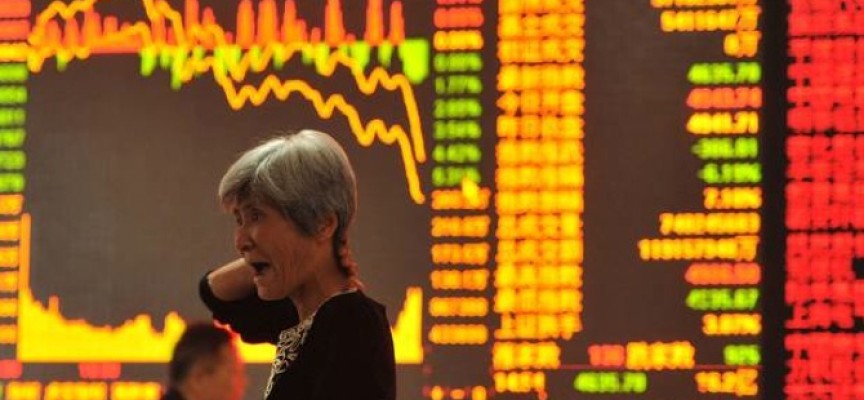Here is a look at what triggered the global selloff in stocks.
Overseas Markets Tumble Hard
September 21 (King World News) – Art Cashin, Head of Floor Operations at UBS: Overnight, global equity markets are positively reeling in response to the reaction to the U.S. markets to the FOMC press conference. In Asia, Japan closed down the equivalent of 500 points in the Dow. Hong Kong was off about 450 points. Mainland China was relatively quiet, down only about 280 Dow points. India had a somewhat similar performance.
In Europe, as we go to press, London is down about 170 Dow points, but Paris is off close to 420 Dow points. Frankfurt is down a little bit less.
In the pre-dawn hours, I sent an email to my friend, the exceedingly thorough, Becky Quick, noting that several of the TV pundits were doing gymnastic turns in trying to pull out the nuances in the Fed statement that caused the market reactions. I noted to Becky what floor traders were talking about at their respective watering holes and that was that in response to the prepared statements, both the official one from the FOMC and Powell’s own prepared statements, equity markets were neutral to actually rallying slightly and, it was only when we got into the randomness of the Q&A that equity prices turned lower and then sharply lower.
So, it was hardly some linguistic nuance, in which, the Fed modified a modifier. It was more the fact that Powell basically admitted the Fed still had some difficulty with controlling things and that they might, in fact, have to tighten further and continue the Quantitative Tightening longer than many had thought. As I say, self-style pundits will look for gems where there is nothing but ordinary rocks.
The post-FOMC calendar is reasonably moderate. It being Thursday, we will get Initial Jobless Claims and then also pre-opening, the Philly Fed Index and the Current Account data. At midmorning, we get Existing Home Sales and Leading Indicators and the Natural Gas Inventories. After the close, everybody will rush to look at the Fed Balance Sheet and see how Quantitative Tightening is going and how much tightening we are actually seeing.
Those who wonder why I keep repeating that the Stock Traders Almanac is so valuable are reminded of this quote from it by Jeff Hirsch, which we cited earlier in the week:
September quarterly options expiration treacherous, week after awful. SP500 down 10 of last 11 September quarterly OPEX Fridays and down 26 of last 33 weeks after.
Some of the swings in bond trading on the FOMC day brought even further attention to some of the inverted yield curves that I have been talking about for weeks, and weeks, and weeks. They may be hinting a bit more strongly that a possible recession could be within sight. We will need to get our abacus re-strung and maybe dig into that next week.
In the meantime, you know the current drill. With all the geopolitical nuances, stay close to the newsticker. Keep your seatbelt fastened. Stay nimble and alert. Keep your eye on those yields. If they stay at, or more importantly, push higher than Wednesday’s relative high closing level, watch carefully to see how the market reacts. They will not have Fed Day as an excuse. Stay safe.
Rates Moving Higher…Again
Peter Boockvar: So when you hear the concept of r* further debated and where the Fed is targeting the fed funds rate relative to inflation, this is how Jay Powell defined it yesterday, “You only know when you get there.” And as to when monetary policy is restrictive, “you know you’re overly restrictive only when you see it.”
I will say this about the prospect of another Fed rate hike, all of a sudden the long end of the yield curve is doing it for them and by almost 50 bps since the July FOMC meeting. The 10 yr yield as risen now by 43 bps since that July get together.
The Fed pause was followed by an unexpected Swiss National Bank pause. They were expected to hike by 25 bps by kept rates unchanged at 1.75%. Remember they started hiking from a level of -.75% so in their eyes they’ve done a lot already, amazingly. Governor Jordan in fact called the tightening so far as “significant” but left door open for more. He said “The significant tightening of our monetary policy over recent quarters is countering remaining inflationary pressure. It cannot be ruled out that a further tightening of monetary policy may become necessary.”
Bank Of England
The Bank of England took the less than expected CPI seen this week and got them to do nothing today too, leaving rates at 5.25% but they are increasing the pace of QT to 100b pounds over the next 12 months vs their previous pace of 80b pounds. The vote was tight as it was 5-4 with the 4 wanting to hike by 25 bps. As the Fed did, they left open the possibility of another hike and higher for longer either way. “Monetary policy will need to be sufficiently restrictive for sufficiently long to return inflation to the 2% target sustainably in the medium term, in line with the Committee’s remit. Further tightening in monetary policy would be required if there were evidence of more persistent inflationary pressures.”
The Bank of Indonesia, the Taiwanese central bank and the one in the Philippines also all left rates unchanged as expected.
In contrast, the Swedish Riksbank and the Norges Bank in Norway both increased rates by 25 bps as expected. The Riksbank said “inflationary pressures in the Sweden economy are still too high” but “Inflation is also falling in Sweden. The rate of increase in energy and food prices has slowed significantly.” They also are not happy with the weakness in the Swedish Krona. As for what comes next, “To ensure that inflation continues downwards and stabilizes around the target within a reasonable period of time, monetary policy needs to be tightened further.”
The Norges bank said to both expect another in December and higher for longer as the Governor said “There will likely be one additional policy rate hike, most probably in December. There will likely be a need to maintain a tight stance for some time ahead.”
Global Debt Level
This global move higher in rates comes with a global debt level of $307 trillion according to the Institute of International Finance which updated this figure on Tuesday as of June 30th. As a percent of global GDP it’s 336%, up from 334% at yr end 2022 but down from 360% during Covid. This debt includes governments, businesses and households. Bottom line, we’re talking about an extraordinary increase in the amount now being paid out in interest expense relative to where we were just a few years ago that will only grow as more and more debt matures in the coming years.
ALSO JUST RELEASED: The Global Debt Market Is Now Flashing Red! CLICK HERE.
ALSO JUST RELEASED: Silver Is Poised To Explode On The Upside, Plus Trouble Brewing On Wall Street CLICK HERE.
ALSO JUST RELEASED: Michael Oliver – Major US Dollar & Gold Update CLICK HERE.
ALSO JUST RELEASED: Monetary Policy Shifts My Rock Global Markets This Week CLICK HERE.
ALSO JUST RELEASED: Gold Coiling To Run Wild, Plus Trouble On The Home Front CLICK HERE.
ALSO JUST RELEASED: Another Gold Bullish Catalyst! Plus People Upset With High Inflation CLICK HERE.
ALSO JUST RELEASED: Global Systemic Change Is Now A Matter Of Survival CLICK HERE.
ALSO JUST RELEASED: China Gold Premiums Skyrocket vs US CLICK HERE.
ALSO JUST RELEASED: Pomboy: SHOCKING: Gold Price In China vs US CLICK HERE.
***To listen to Alasdair Macleod’s powerful audio interview about what is happening in China and the West in the gold market CLICK HERE OR ON THE IMAGE BELOW.
© 2023 by King World News®. All Rights Reserved. This material may not be published, broadcast, rewritten, or redistributed. However, linking directly to the articles is permitted and encouraged.








